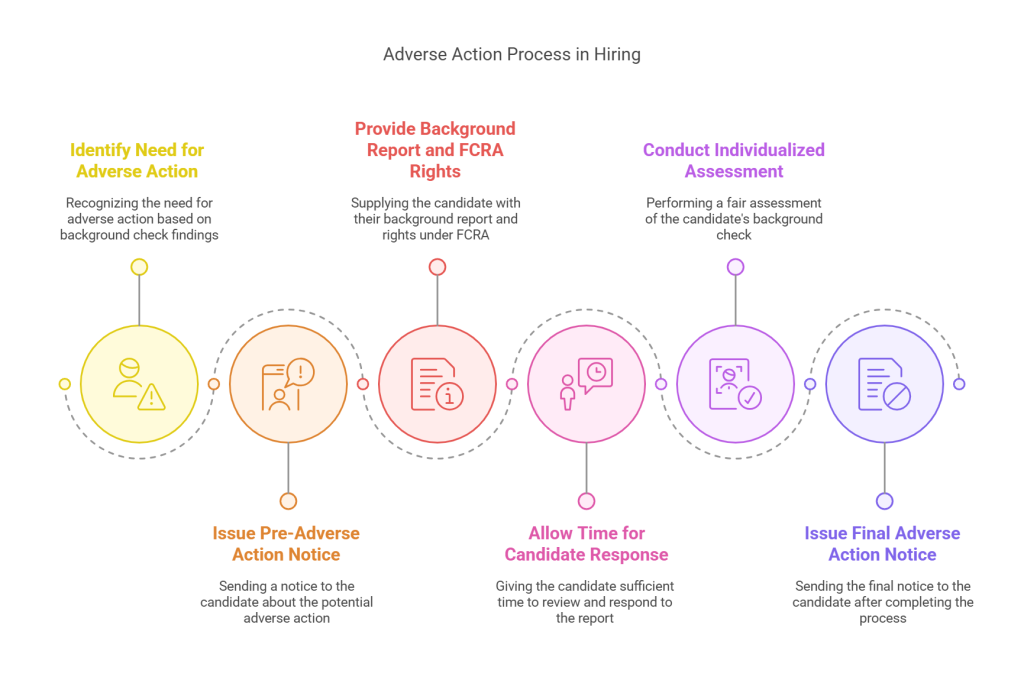Navigating the minefield of legal compliance in HR can be demanding, especially regarding adverse actions following a background check. Taking an adverse action, such as not hiring someone based on their background report, involves a series of critical steps that, if handled improperly, can lead to legal repercussions for your organization.
This guide will help HR professionals and recruiters identify common adverse action mistakes and, more importantly, how to avoid them. You can ensure that your adverse action processes are legally compliant and fair with the proper knowledge and techniques.
Key Takeaways
- Adverse action is a legal process employers must follow when making unfavorable employment decisions based on background check results.
- Common mistakes include failing to provide proper notice, not allowing sufficient time for candidate response, and inconsistent application of policies.
- Employers must provide a pre-adverse action notice, a copy of the background check report, and a summary of rights under the FCRA.
- After the waiting period, if the decision stands, a final adverse action notice must be sent.
- It's crucial to have a consistent, documented process for adverse actions to ensure compliance and fairness.
- Regular training for HR staff on adverse action procedures can help prevent costly mistakes and potential legal issues.
- Employers should consider individualized assessments and be open to explanations from candidates before making final decisions.
Introduction
When navigating the labyrinth of legal compliance in Human Resources, few areas are as precarious as handling adverse actions following a background check. A single misstep can transform a routine hiring procedure into a legal quagmire.

So, what exactly are adverse actions? In the scope of HR, an adverse action is any decision that negatively impacts an applicant's employment status based on information in their background report. This might include not hiring someone, denying a promotion, or firing an existing employee.
These decisions transcend mere business choices; they are legal intricacies requiring rigorous compliance with established guidelines, such as the Fair Credit Reporting Act (FCRA). Maintaining adherence to these standards is imperative to safeguard the organization against potential legal repercussions and to uphold ethical hiring practices.
The significance of following proper procedures cannot be overstated. Failure to comply with legal requirements can result in lawsuits, hefty fines, and a tarnished company reputation. This article will walk you through the most common adverse action mistakes and provide actionable strategies to avoid them, ensuring your practices remain fair and legally compliant.
By understanding and implementing the right procedures, HR professionals and recruiters can steer clear of costly errors, protect their organizations, and uphold high standards of fairness in hiring practices.
What is an Adverse Action?
In the context of human resources and background checks, an adverse action refers to a decision that negatively impacts an individual’s employment prospects or status based on information obtained during the background screening process. This could include not hiring a candidate, terminating an employee, or refusing a promotion due to findings in their background report.
Significance in Hiring
Adverse actions play a critical role in maintaining fair and lawful hiring practices. When executed properly, they help ensure that decisions are made based on relevant, accurate, and legally permissible information. They signify an organization's commitment to safety, integrity, and regulatory compliance, which can ultimately protect the organization from potential legal issues.
Legal Framework
Navigating the legal landscape is a key aspect of managing adverse actions. The Fair Credit Reporting Act (FCRA) outlines specific procedures and protections for individuals undergoing background checks. Under the FCRA, employers must follow a set protocol before taking adverse action, including providing a pre-adverse action notice, a copy of the background report, and a summary of the individual's rights under the FCRA. Failure to adhere to these guidelines can lead to lawsuits and penalties. For detailed regulations and compliance guidance, consult resources like the EEOC, which provide essential information to help employers remain within legal boundaries.
EXPERT INSIGHT: Adverse actions in HR can have profound and lasting impacts on affected individuals, whether it’s not getting a job or losing one they already have. Therefore, it is imperative to have a clearly defined policy around adverse actions to ensure fair treatment for all. Read on to better understand the potential pitfalls and learn how to avoid them. - Emile Garcia, SHRM-SCP, CHRP, CHRBP
Adverse Action Mistake #1: Failing to Provide a Pre-Adverse Action Notice
One of the biggest pitfalls when handling adverse actions is not issuing a pre-adverse action notice. This notification is essentially a heads-up to the candidate that you are considering taking an adverse action based on information found in their background check.
What it is
A pre-adverse action notice is a preliminary alert sent to the candidate, informing them that an unfavorable hiring decision is being considered due to findings in their background report. This notice is mandated under the Fair Credit Reporting Act (FCRA) to ensure transparency and give the candidate a fair chance to address any discrepancies or issues.
Why It’s Crucial
Failing to provide a pre-adverse action notice isn't just a minor slip-up; it can lead to significant legal trouble. Non-compliance with the FCRA can result in hefty fines and lawsuits, putting your organization at risk. Beyond the legal implications, there’s the ethical aspect: it’s only fair to allow candidates to rectify potential mistakes or provide context to the information found.
What You Should Do to Avoid this Mistake
- Draft a Clear, Concise Notice: Ensure your pre-adverse action notice is straightforward, telling the candidate that you’re considering an adverse action based on their background report.
- Include All Necessary Documents: Attach a copy of the background report and the “Summary of Rights Under the FCRA.” This allows candidates to review what was found and understand their rights.
- Explain the Process: Inform candidates about the steps they should take if they wish to dispute the findings. Provide clear instructions and contact details for further assistance.
- Set a Reasonable Timeline: Give candidates ample time to respond. Five business days is a fair period during which candidates can address any issues.
By meticulously issuing a pre-adverse action notice, you adhere to legal mandates and foster a fair and transparent hiring process. Sure, it adds a couple of extra steps, but considering the potential fallout from skipping this duty, it's a small effort well worth making.
Adverse Action Mistake #2: Not Including a Copy of the Background Report and FCRA Summary of Rights
A common yet critical error is failing to provide a copy of the background report and the "Summary of Rights Under the FCRA" with your pre-adverse action notice.
What it is
When you decide to take a pre-adverse action based on a candidate's background check, you're required by the Fair Credit Reporting Act (FCRA) to include both the report itself and a summary of their rights. This informs the candidate about the information being used against them and their legal rights concerning that information.
Why It’s Crucial
Skipping this step exposes your organization to significant legal risks. Without the background report, candidates lack the essential context to understand the employer's decision-making. And without the Summary of Rights, they might remain ignorant of their entitlement to dispute or discuss the findings. This oversight can lead to disputes, penalties, and possibly even lawsuits.
What You Should Do to Avoid this Mistake
Here’s how to ensure you include these crucial documents:
- Automate the Process: Use HR software to automatically bundle the background report and the Summary of Rights with your pre-adverse action notices.
- Double-Check Before Sending: Have a checklist in place. Before sending any notices, confirm that these documents are included.
- Clear Communication: Ensure the pre-adverse action notice explains the documents and why they’re included. This will avoid confusion and promote transparency.
- Stay Updated: Periodically review your templates to ensure compliance with the latest FCRA guidelines and updates.
By thoroughly following these steps, you will adhere to legal requirements, streamline your hiring process, and foster a more transparent relationship with your candidates.
Adverse Action Mistake #3: Not Giving the Candidate Enough Time to Respond
When it comes to adverse actions, time is more than just money—it's a legal necessity. Candidates need an opportunity to review and contest the information in their background reports. But what exactly does it mean to give them "enough time"?
What it is
"Enough time" typically translates to a reasonable period for the candidate to respond to the pre-adverse action notice. According to industry best practices, this period is generally no less than five business days. This window allows candidates to dispute errors, provide context to adverse information, or gather the necessary documents to defend their case.

Why It’s Crucial
Failing to provide adequate time for a response can lead to several complications. Firstly, it compromises the fairness of the hiring process. More critically, cutting this corner exposes your company to legal risks, including non-compliance with the Fair Credit Reporting Act (FCRA). A rushed adverse action process can result in lawsuits, fines, and damage to your employer brand.
What You Should Do to Avoid this Mistake
- Clear Communication: Clearly state in your pre-adverse action notice that the candidate has a specific number of business days to respond. Five business days is a strong benchmark, but consider extending it to seven if the complexity of the information warrants it.
- Document Everything: Keep meticulous records of when the pre-adverse action notice was sent and any communication received from the candidate within the response window.
- Accessible Contact Methods: Ensure that candidates can easily reach your HR department. Providing multiple contact methods (e.g., email, phone) can facilitate a quicker and more effective communication process.
- Internal Checkpoints: Set internal reminders to follow up if the initial response period gets close to expiring without a response. This ensures no notices fall through the cracks.
- Flexibility for Extensions: Consider requests for additional time on a case-by-case basis, especially if the candidate demonstrates a valid need for more time to gather information or address discrepancies.
Adhering to these best practices can help ensure that every candidate receives fair treatment and that you stay firmly within the bounds of legal requirements. This attention to detail minimizes risks and strengthens your reputation as a fair and responsible employer.
Adverse Action Mistake #4. Not Conducting an Individualized Assessment
When it comes to adverse actions based on background checks, a one-size-fits-all approach doesn’t cut it. The EEOC recommends an individualized assessment to ensure fair and contextually sound decisions.
What It Is
An individualized assessment means taking a closer look at the specific details surrounding a candidate's background check findings instead of making an automatic determination based on the existence of a negative mark.
Why It’s Crucial
Conducting an individualized assessment isn't just about adhering to legal guidelines; it's also about ethical hiring practices. Legally, it helps protect your organization from potential lawsuits and discrimination claims. Ethically, it recognizes that candidates are more than just their background reports. They bring unique experiences, skills, and extenuating circumstances that deserve consideration.
Moreover, giving candidates a fair chance can enhance your company's reputation, making it a desirable workplace and promoting diversity and inclusivity. Neglecting this step can lead to unjust exclusions from the hiring process, potentially forfeiting top talent over uncontextualized findings.
What You Should Do to Avoid this Mistake
To conduct an effective individualized assessment, follow this checklist:
- Review the Nature and Gravity of the Offense: Understand what the offense was and its seriousness. Not all offenses have the same weight and relevance to the job position.
- Consider the Time Passed Since the Offense: Factor in how much time has elapsed since the offense occurred. Generally, older offenses are less relevant, especially if the candidate has demonstrated a stable and offense-free lifestyle since.
- Evaluate the Relevance to the Job: Assess the relationship between the offense and the job's responsibilities. For instance, a financial offense might be more relevant to a banking role than a manual labor position.
- Gather Additional Context: Provide the candidate with an opportunity to explain the offense's circumstances. This could include rehabilitation efforts, character references, or evidence of positive contributions since the offense.
- Document Your Assessment: Carefully document each step of your individualized assessment process. Include notes on each factor considered and the final decision rationale. This documentation can be invaluable if your decision is later challenged.
By incorporating these steps, you'll be better equipped to make informed, fair, and legally compliant hiring decisions that reflect the full context of a candidate's background.
Adverse Action Mistake #5: Issuing the Final Adverse Action Without Following Proper Procedures
Issuing a final adverse action notice is the concluding step in the adverse action process. It signifies the decision not to hire a candidate based on the findings of their background check. Treating this step with the utmost diligence is crucial to avoid legal pitfalls.
What It Is
A final adverse action notice must include several key components: a clear statement that an adverse action is being taken, the specific reasons for the decision, information about the company that provided the background report, and a reiteration of the candidate's rights under the FCRA. These elements ensure transparency and give the candidate the necessary information to understand the decision and take further action.
Why It’s Crucial
Adhering to the proper procedures when issuing the final adverse action notice can have serious consequences. Non-compliance can result in lawsuits, fines, and a damaged reputation for your organization. To mitigate these risks, it's essential to illustrate a commitment to fairness and legal adherence.

Best Practices to Avoid this Mistake
Here are the steps to ensure your final adverse action procedures are compliant:
- Draft a Clear Notice:
- Include a straightforward statement that outlines the adverse action.
- Specify the reasons for the decision derived from the background report's findings.
- Provide Information About the Reporting Agency:
- Mention the contact details of the consumer reporting agency that furnished the background report.
- State that the agency did not make the adverse decision and cannot provide specific reasons.
- Include FCRA Summary of Rights:
- Reiterate the candidate’s rights, including their right to dispute the accuracy or completeness of the report.
- Refer to the Summary of Rights already provided during the pre-adverse action notice.
- Maintain Documentation:
- Keep thorough records of all communications and notices sent throughout the adverse action process.
- Ensure that all documentation is stored securely and is accessible if required for legal purposes.
- Double-Check Compliance:
- Conduct a final review to ensure all procedural steps comply with relevant legal requirements.
- Use checklists or compliance management software to verify that nothing is overlooked.
Adhering to these best practices will allow you to confidently navigate the complexities of the adverse action process and ensure that your decisions are compliant, respectful, and transparent.
Steps to Ensure Legal Compliance
Audit Your Current Process
First, you need to know where you stand. Conduct a thorough audit of your existing adverse action procedures. Look for gaps, redundancies, or any steps where compliance might be at risk. Pay special attention to your documentation and communication processes. Are you issuing pre-adverse and adverse action notices consistently? Are those notices compliant with the FCRA guidelines? Make a list of areas that need improvement and set specific, actionable goals for addressing them.
Training for HR Professionals
Knowledge is power. Equip your HR team with the training to navigate adverse actions competently. Organize workshops or online courses focusing on FCRA guidelines and EEOC recommendations. Update your team whenever legislation changes to ensure ongoing compliance. Educated teams are less likely to make costly adverse action mistakes, and they’ll feel more confident in their roles.
Utilizing Technology
Don’t do it all manually. Leverage technology to streamline your adverse action processes. Various HR software solutions are designed to efficiently manage background checks and adverse actions. These platforms often have built-in compliance tools, automatically generating necessary documents and keeping track of timelines so you don’t have to. This minimizes human error and ensures all steps are executed according to legal standards.
By auditing your processes, training your team, and utilizing technology, you’ll build a robust framework that ensures your adverse actions are compliant and fair.
Legal Resources and References
Navigating legal compliance in the adverse action process can be daunting, but knowing where to find trusted resources can make all the difference. Here are key references to help you stay informed and compliant:
- EEOC Guidelines: The U.S. Equal Employment Opportunity Commission (EEOC) provides extensive guidelines on handling employment decisions fairly and legally. Explore comprehensive laws and regulations at the EEOC website.
- Professional Background Screening Association (PBSA): The PBSA offers valuable information on best practices and legal requirements for background screening. Access their resources at PBSA.
- Additional Reading: For more detailed insights, check out internal resources like Common Background Check Questions and general HR guides on the GCheck Blog.
By leveraging these resources, HR professionals and recruiters can stay well-informed and confidently navigate the complexities of adverse action.

Conclusion
Navigating the intricacies of adverse actions in hiring can indeed be a challenge, but it's one that every HR professional needs to master. By understanding the common mistakes—such as failing to provide a pre-adverse action notice, not including the necessary documents, not giving candidates sufficient time to respond, neglecting individualized assessments, and mishandling final adverse action notices—you can significantly reduce the risk of legal repercussions.
Remember, each step ensures fairness and transparency in the hiring process. They protect your organization and the candidates, fostering a more ethical workplace environment.
Stay vigilant, continually educate yourself on the latest legal requirements, and integrate best practices into your hiring procedures. Doing so will build a compliant, fair, and trustworthy recruitment process that benefits everyone involved. Keep striving for excellence in your HR practices, knowing that each improvement brings you one step closer to a legally sound and just hiring process.
Still have questions?
Get in touch with our team today for a personalized demo and discover how our tailored volume pricing and packages can drive results for your business!
How useful was this page?*
Note: your comments are anonymous. We use them to improve the website. Do not include any personal details.
Visit our FCRA Compliance Tool or leave a message here if you need a response.
From the blog Explore the GCheck Content Hub

Building a Strategic Screening Framework for International Hires in 2026
14 Jan, 2026 • 15 min read
Drug Testing Policies for Remote Employees: A 2026 Compliance and Strategy Guide
13 Jan, 2026 • 21 min read
Best Background Checks for Temporary Workers: A Strategic Framework for 2026
13 Jan, 2026 • 15 min readThe information provided in this article is for general informational and educational purposes only and should not be construed as legal advice or a substitute for consultation with qualified legal counsel. While we strive to ensure accuracy, employment screening laws and regulations—including but not limited to the Fair Credit Reporting Act (FCRA), Equal Employment Opportunity Commission (EEOC) guidelines, state and local ban-the-box laws, industry-specific requirements, and other applicable federal, state, and local statutes—are subject to frequent changes, varying interpretations, and jurisdiction-specific applications that may affect their implementation in your organization. Employers and screening decision-makers are solely responsible for ensuring their background check policies, procedures, and practices comply with all applicable laws and regulations relevant to their specific industry, location, and circumstances. We strongly recommend consulting with qualified employment law attorneys and compliance professionals before making hiring, tenant screening, or other decisions based on background check information.


